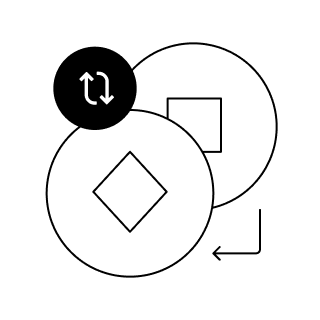What’s Ordinals (ORDI)? How can I buy it?
What is Ordinals?
Ordinals is a protocol for numbering and tracking individual satoshis—the smallest units of Bitcoin—and enabling arbitrary data to be inscribed directly onto them. In practice, this turns selected satoshis into on-chain digital artifacts (often called inscriptions) that can contain images, text, videos, or application data. These artifacts resemble NFTs conceptually, but with a crucial distinction: they live natively on Bitcoin’s base layer without requiring separate sidechains, smart contracts, or off-chain storage.
Introduced in early 2023 by Casey Rodarmor, Ordinals leverage upgrades like SegWit (2017) and Taproot (2021), which increased block capacity and made it cheaper and more flexible to store data in transactions. The emergence of Ordinals sparked a wave of Bitcoin-native collectibles, art, and even experimental fungible token schemes (e.g., BRC-20), reinvigorating developer activity and debate around Bitcoin’s purpose and scalability.
Key ideas:
- Ordinal theory assigns a deterministic, canonical index to each satoshi.
- Inscriptions attach data directly to a satoshi via standard Bitcoin transactions.
- Artifacts are fully on-chain, inheriting Bitcoin’s security and permanence.
Reputable references and background:
- Casey Rodarmor’s original Ordinals documentation and blog posts
- Bitcoin Core documentation on transaction structure, SegWit, and Taproot
- Academic and industry analyses on Bitcoin blockspace economics and data embedding
How does Ordinals work? The tech that powers it
At a high level, Ordinals combines a deterministic satoshi indexing scheme (ordinal theory) with Taproot-enabled data inscriptions that live in the witness section of Bitcoin transactions.
- Ordinal theory: indexing satoshis
- Satoshis are ordered by their position in the Bitcoin issuance and transaction history. Each has a unique ordinal number based on the sequence in which it was mined and subsequently transferred.
- Ownership of a satoshi (and thus of an inscription attached to it) follows normal Bitcoin UTXO ownership. If you control the UTXO that contains the inscribed satoshi, you control the artifact.
- This deterministic mapping allows wallets and indexers to track specific sats through inputs and outputs as they are spent, merged, or split.
- Inscriptions: embedding data on-chain
- Data payloads are included inside Taproot script paths in the transaction witness. SegWit moved witness data outside the traditional block size limit and introduced a weight-based accounting that makes witness data cheaper per byte than legacy data.
- Taproot enables compact, flexible scripts and the ability to commit to arbitrary data more efficiently. Ordinals use this capability to embed content (e.g., images) directly in-chain.
- The inscription process typically involves:
- Constructing a Taproot transaction with an inscription payload
- Broadcasting and confirming the transaction
- Indexing software (ordinal indexers) scans the chain, identifies the inscription, and associates it with a particular satoshi inside a UTXO
- Ownership and transfers
- Inscribed sats are transferred just like any other Bitcoin. However, wallet software must be “ordinal-aware” to avoid accidentally spending or fragmenting the specific satoshi that carries the inscription.
- Best practice is to isolate inscribed sats in dedicated UTXOs and use compatible wallets that preserve ordinal ordering and clearly display inscriptions.
- Infrastructure and standards
- Indexers: Off-chain indexers parse the blockchain, reconstruct satoshi order, and map inscriptions to sats. While the data is on-chain, discovery and display rely on indexers and explorers.
- Wallets/marketplaces: Specialized wallets and marketplaces provide safe transfers, listing, and viewing of artifacts. They implement rules to avoid “cursing” or misplacing inscriptions, handle sat selection, and present metadata.
- BRC-20 and related experiments: Building atop the same inscription mechanism, BRC-20 represents a convention for fungible tokens using JSON inscriptions and transfer logs. It is not a native Bitcoin token standard but an emergent, indexer-enforced schema.
- Constraints and trade-offs
- Blockspace economics: Inscriptions consume block space, competing with payment transactions. This can raise fees during demand spikes and has revived debates about Bitcoin’s long-term fee market.
- Permanence and immutability: Because inscriptions are on-chain, content is effectively permanent and globally replicated. This raises curation and moderation questions and increases full-node storage growth.
- Compatibility and censorship resistance: Ordinals use standard Bitcoin transactions without protocol changes, benefiting from Bitcoin’s censorship resistance and network effects, but are bounded by Bitcoin’s scripting limits and throughput.
What makes Ordinals unique?
- Bitcoin-native digital artifacts: Unlike most NFTs that depend on smart contracts and often off-chain metadata, Ordinals inscriptions store content directly in Bitcoin’s base layer. This confers strong permanence and security.
- Deterministic sat-level provenance: Each artifact is anchored to a specific satoshi with a clear provenance trail through UTXOs—an uncommon granularity in digital collectibles.
- Leverages Bitcoin’s upgrades: Ordinals creatively exploit SegWit’s witness discount and Taproot’s flexible data commitments without altering consensus rules.
- Cultural and economic impact on Bitcoin: Ordinals broadened Bitcoin’s use beyond payments and “digital gold,” catalyzing new creator economies, fee spikes, and renewed discourse about blockspace as a scarce commodity.
- Minimal-trust architecture: No sidechains or external consensus are required. While indexers aid discovery, the artifact data is self-contained on-chain.
Ordinals price history and value: A comprehensive overview
Important clarification: “Ordinals” as a protocol does not have a native coin or token. Value accrues to:
- Individual inscriptions/collections (Bitcoin-native digital artifacts)
- Related experimental tokens like BRC-20 (which are conventions, not base-layer assets)
- Bitcoin miners (via fees) and Bitcoin itself (through demand for blockspace)
- Infrastructure (wallets, marketplaces, indexers) and creators
Market dynamics since launch (2023 onward):
- Early collections and low inscription IDs have tended to command premiums due to historical significance and scarcity.
- High-profile artist drops, culturally resonant pieces, and technically novel inscriptions have seen substantial secondary market activity on Bitcoin-focused marketplaces.
- BRC-20 boom-bust cycles: Periods of intense activity drove surges in inscription counts and mempool congestion, with fees spiking and then normalizing. Prices of specific BRC-20 tickers have been highly volatile and speculative.
- Fee market influence: Waves of inscription demand materially increased miner revenue at times, occasionally outpacing the block subsidy on single blocks. This underlines the macro narrative that non-payment use cases can support Bitcoin’s long-term security budget.
Valuation considerations:
- Provenance and rarity (early inscription numbers, notable creators, unique traits)
- On-chain permanence vs. off-chain dependencies (fully on-chain media generally valued higher)
- Market infrastructure maturity (liquidity, safe transfer tools)
- Broader crypto market conditions, Bitcoin price, and risk appetite
Because markets are fragmented and fast-moving, consult reputable marketplaces, analytics dashboards, and indexers for up-to-date pricing and sales histories. Always verify that an artifact is genuinely on-chain and that you control the inscribed sat.
Is now a good time to invest in Ordinals?
This is not financial advice, but here are frameworks and risks to consider:
Potential reasons to allocate:
- Long-term thesis on Bitcoin-native culture: If you believe Bitcoin’s base layer will host enduring digital artifacts, scarce early inscriptions and blue-chip collections could hold historical value.
- Security budget narrative: Sustained demand for inscriptions supports miner fees, potentially strengthening Bitcoin’s long-term sustainability—a meta thesis some investors find compelling.
- Creator and developer momentum: Tooling, marketplaces, and standards are evolving rapidly, which may enhance usability and liquidity over time.
Key risks:
- Speculative excess and illiquidity: Many inscriptions and BRC-20 assets have thin markets and wide bid-ask spreads. Prices can be highly reflexive and volatile.
- Technical handling risk: Without ordinal-aware wallets, you may accidentally spend or fragment inscribed sats. Operational mistakes are a real risk.
- Regulatory uncertainty: Jurisdictions may treat certain digital artifacts or token-like inscriptions as securities or subject them to consumer protection regimes.
- Fee environment: High fees can impair usability and change participation dynamics. Conversely, falling interest can depress prices and liquidity.
- Indexer conventions: While data is on-chain, many token-like behaviors depend on social consensus enforced by indexers. Changes in indexer rules or fragmentation of standards can affect asset recognition.
Practical guidance:
- Use reputable, ordinal-aware wallets and verify UTXO isolation for inscribed sats.
- Start with small, well-researched positions. Prioritize artifacts with clear provenance, creator reputation, and fully on-chain media.
- Diversify across themes (historical inscriptions, art, utility-focused artifacts) if you plan broader exposure.
- Track miner fee trends, mempool conditions, and marketplace liquidity.
- Stay current with protocol/tooling updates from credible sources (developer blogs, Bitcoin-focused research, recognized marketplaces).
In summary, Ordinals transform individual satoshis into Bitcoin-native digital artifacts using SegWit and Taproot, unlocking new cultural and economic layers on Bitcoin. The opportunity is intriguing but comes with significant technical and market risks. Careful tooling, due diligence, and a long-term perspective are essential for anyone considering participation.
Discover the different ways to buy crypto in the UAE
Create an OKX account
Get verified
Start a trade
Enter an amount
Choose your payment method
Confirm your order
All done
Get the OKX app or Wallet extension
Set up your wallet
Fund your wallet
Find your next purchase
Note:
Tokens with the same symbol can exist on multiple networks or may be forged. Always double-check the contract address and blockchain to avoid interacting with the wrong tokens.
Trade your crypto on OKX DEX
Choose the token you’re paying with (e.g., USDT, ETH, or BNB), enter your desired trading amount, and adjust slippage if needed. Then, confirm and authorize the transaction in your OKX Wallet.
Limit order (optional):
If you’d prefer to set a specific price for your crypto, you can place a limit order in Swap mode.
Enter the limit price and trading amount, then place your order.
Receive your crypto
All done

Make informed decisions















